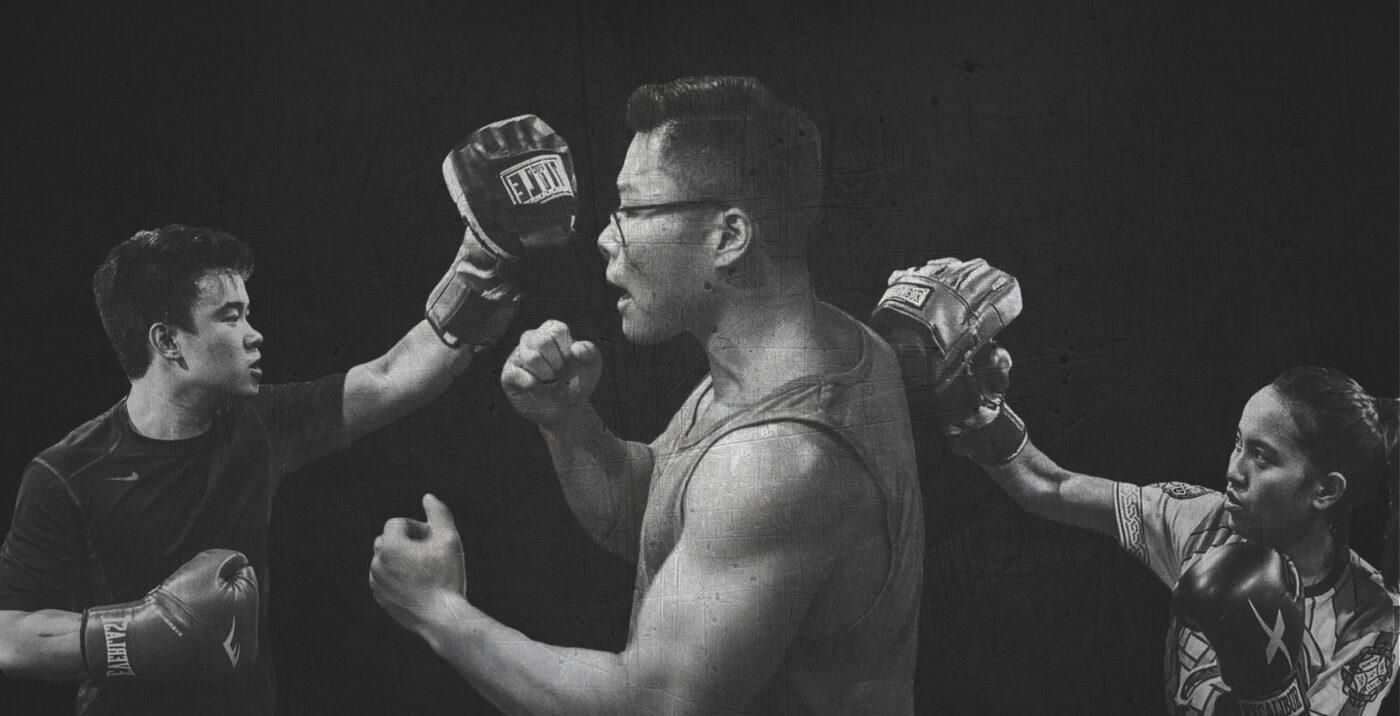MIXED MARTIAL Arts (MMA), in all its raw glory, attracts many fans simply craving to catch a knockout. In a spectacle of combat that pushes the human boundaries of physicality, fights become more than just an exchange of punches—it turns into a test of pain, passion, and power that transforms the average fighter into a warrior at the bell.
Touch gloves
Last October 20, six Atenean fighters tested their mettle under the lights and cameras as they entered the octagon in an insane night of brawl and school pride at the first Forza Underground Mixed Martial Arts Tournament at the Ynares Sports Arena in Pasig City.
Bruisers Kiel Cabasal, Mark Balmes, Ali Castro, Gab Fajardo, Karl Corro, and Kashmir Yap donned their gloves to bring the “one big fight” to a new field of athletic combat. While only Cabasal, Castro, and Yap ended the night in victory, the newest batch of blue-blooded brawlers achieved much for their craft, placing amateur fighting in the public spotlight to give it much needed exposure.
For these young warriors, the tournament serves as a major career boost. The boiling passion from a swelling Filipino fanbase could provide an avenue for student fighters to showcase their skills on a grand platform, giving die-hards and curious spectators a chance to witness the revolutionary sport first-hand.
True enough, the inaugural MMA showdown was electrifying. For the first time in history, student Filipino MMA fighters earned the limelight on a night that pushed the boundaries of local sports. In watching any sport, viewing digital screens simply pales in comparison to witnessing the action live, and Forza magnified this principle entirely. The experience of seeing these talented student fighters at work may spark an upswing in popularity for a sport that goes beyond the walls of the octagon.
Discipline through the punches
More than a battle of grapples, punches, and kicks, MMA’s true beauty lies not in violence, but in the training that it requires outside the view of the crowd. For this new generation of athletes, MMA is a life path, teaching the discipline to move past limitations to achieve a better form of oneself. The fighters’ endeavors at Forza were just the start of a rising trend in Manila’s athletic scene, setting off a movement where fighters find themselves and learn on the mat.
For some of the fighters, MMA offers a lesson in humility, instructing combatants to learn how to be graceful in defeat. Experience truly was the best teacher in this sense for Mark Balmes, who lost to Jeg Sandoval, a taller bruiser from the University of Santo Tomas. For Balmes, the loss gave him the drive to improve after understanding the limits of his own strength.
“You never know how strong you are until you take a beating,” says Balmes. “MMA gives me that confidence to be less scared when [faced with] danger.”
When it comes to a straight-up beatdown, fighters cannot afford to show fear, which is both a deterrent for the opponent and for one’s own self-confidence. “Not many realize this, but when you’re walking in there, the only thing on your mind is ‘I’m gonna die, I’m gonna die,’” jokes Corro. “It really trained me to be mentally stoic and tough—and a bit more compassionate.”
Compassion and care are two words one would not usually associate with a sport that pits fighters in all-out brawls. But for others, the first instinct when their opponents go down is not to acknowledge weakness, but rather show concern.
The road to the octagon
The thrashing adrenaline is definitely intense, but MMA is the lifestyle these warriors chose. While fighting leaves him breathless and sore, Balmes says he feels satisfied and inspired from training. Sore fists and aching bodies are the name of the game, but the fighters take home lessons that are more lasting than bruises.
These virtues are first sown in the beatings they receive and in the hours of sweat, bruises, and blood spent before any fight. To the ordinary fighter, pain is weakness leaving the body. It means that champion or not, the student athlete lives out a cycle of discipline, training constantly and obeying strict diets that involve calorie counting and intake monitoring.
But despite the physical struggles, there is no avoiding the academic burden, which comes with the identity of the athlete. “I sacrificed my acads to train hard,” says Yap. “It’s a sacrifice that not many want to take.”
The Future of MMA
Yap’s sacrifices paid off during Forza as he emerged victorious in the main event. Going pro was always his plan, and this became closer to reality with his win. Commentators Del Bacho and Louie Sangalang even saw the victory as the birth of a star.
After the tournament, the Universal Reality Combat Championship (URCC) scouted Yap and convinced him to go pro, but he declined. He wants to compete first in boxing, jiu jitsu, then eventually MMA. “I want to be considered one of the greatest of all time in the sport. I want to climb the peak. It’s what I’ve wanted to do since I was a kid,” he said.
Big words show big promise. But Yap, along with the other Atenean fighters, echo the same sentiments for the sport. The media attention and booming fanbase may just get the ball rolling for MMA in the Philippines, and Yap believes that the fanbase will only balloon in the next five years.
“Casual fans are popping up because of the sport and of course fighters like Conor McGregor. MMA is getting bigger,” shares Yap.
While the sport continues to thrive, so do the young and hungry warriors, who have been affected by the sport immeasurably. As the art of combat waits to make another splash, but the next generation of fighters have already made their mark by leading the fight for a new athletic movement.
Editor’s Note: Mark Balmes is a current Research staffer for The GUIDON.







